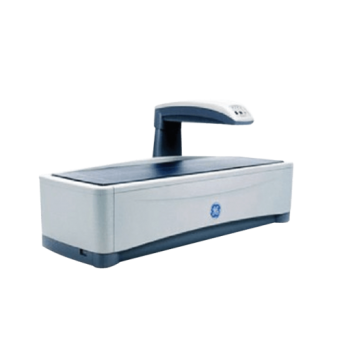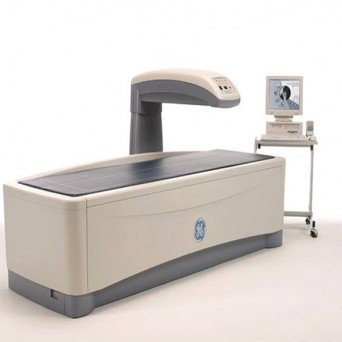Bone Densitometers (DEXA)
Bone Densitometers (DEXA)
The Dual X-ray Absorptiometry (DEXA) scanner is an innovative device for measuring bone density. This test provides a reliable diagnosis of osteoporosis and other dangerous bone diseases. DEXA utilizes the use of X-rays of two different energies, allowing the scanner to distinguish between bone and soft tissue. DEXA provides much clearer and more precise images than standard X-rays. In this category, we offer efficient used densitometers (DEXA) so you can perform efficient and accurate diagnosis of brittle bones in your medical facility.
Imaging with a DEXA scanner
Bone density scanning with a DEXA densitometer is a painless test. The patient lies motionless on his or her back on a large open X-ray table with a moving scanning arm above it. The examination takes about 10-20 minutes. The scan provides a complete measurement of the mineral content and density of the bones from around the spine, pelvis, hip, forearm or thigh. Based on the highly accurate DEXA imaging results, it is possible to evaluate the reduction of bone mass, determine their bone fragility and susceptibility to fracture. This is a key diagnostic procedure in the verification of osteoporosis and osteopenia. The very high quality of DEXA imaging and the exceptional accuracy of the scan make it possible to detect pathological changes at a very early stage, when planned treatment can be beneficial and effective. Standard diagnostic radiology does not provide such capabilities, as it only highlights large lesions that may be too advanced to treat. The used DEXA scanners we offer are operational and highly efficient. They are full-featured medical equipment that will allow you to conduct bone density testing at your medical facility at a low cost.
Application of DEXA scanner
It is widely believed that in the current state of medical research, the DEXA scan is the most useful and reliable test for confirming or ruling out osteoporosis or osteopenia. Bone Densitometers DEXA, also known as X-ray absorptiometry, uses a very low dose of ionizing radiation, so it is a test that is not only non-invasive and painless, but also accurate and relatively safe for the patient. The DEXA scanner is based on improved X-ray technology for measuring bone mass loss. It produces two beams of radiation. One is high-energy and the other is low-energy. The scanner measures the amount of radiation passing through the bones. The radiation beams will indicate a different value depending on how thick the bone is. Based on the differences indicated by the DEXA scanner, the medical staff assesses the bone density. Testing with Bone Densitometers (DEXA) is most often used during the diagnostic procedure for osteoporosis and osteopenia. Osteoporosis is a metabolic disease that results in a drastic decrease in bone density causing a risk of fractures. Osteoporosis is most common in postmenopausal women, it also affects men, the elderly, and is less common in children. Osteopenia is a disease in which there is a decrease in bone mineral density, but with maintenance of the capacity for proper mineralization. It is imperative to diagnose and treat this condition, as it can lead to osteoporosis or other complications. Osteopenia occurs in peri-menopausal women and the elderly, but it also occurs in other patients, including the young. It can be caused by poor diet, deficiency of calcium, vitamins C, K and D, comorbidities of other diseases, obesity, or being underweight. Patients suffering from thyroid disease, diabetes, rheumatoid arthritis, kidney or liver disease, and those with a family history of osteoporosis or osteopenia are also at risk.
Bone Densitometer (DEXA) design and bone scan results
The most commonly used DEXA scanner is a central stationary device for measuring bone density. It consists of a flat large table and a long movable arm containing a detector or scanning device. The table design includes an X-ray generator. During scanning, the arm moves very slowly over the patient generating an image on the monitor of an integrated computer. The results of the DEXA scan are classified by comparing the bone density with that expected for a young healthy adult or a healthy adult of a specific age, gender and ethnicity. BMD is determined by the difference between the patient's actual measurement and the assumed baseline parameter of a young healthy adult. This difference as the standard deviation (SD) is described as the T-Score. In contrast, the difference between the patient's measurement and that of a person of the same age is described as the Z-Score. A T-score in the range of 1 SD (+1 or -1) is a normal value, ranges from 1 to 2.5 SD (-1 to -2.5 SD) show low bone mass, while parameters of 2.5 and above (above -2.5 SD) indicate osteoporosis.
Used Bone Densitometers in the radiology room at your medical facility
In this category you will find used fully operational and efficient Bone Densitometers prepared for intensive use in your medical facility. Nowadays, bone density testing is a standard and necessary procedure that should be performed among patients every two years, or more often if you belong to a risk group. The used medical equipment we offer is very carefully verified for suitability and efficiency. Our qualified team of experts performs a thorough diagnosis of the acquired used bone densitometer (DEXA) to prepare it for diagnostic work in your medical facility. We offer used medical equipment of high quality. We deliver used Bone Densitometer to customers all over the world, the medical equipment is very well protected in shipment and sent by courier service. Using our offer of used Bone Densitometers, you have the opportunity to supply your medical facility with efficient and effective medical equipment at a very bargain price. If you have additional questions about the used and refurbished medical equipment we offer, including used Bone Densitometers, please contact our Medsystems team.


